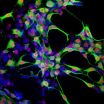'Glowing hands' in the waiting room improves kids' handwashing
2011-06-16
(Press-News.org) CHICAGO (June 15, 2011) – Use of a glowing gel that shows kids how well they wash their hands by illustrating bacteria they missed while washing and may significantly improve hand hygiene, according to a study published in the July issue of Infection Control and Hospital Epidemiology, the journal of the Society for Healthcare Epidemiology of America. What makes this particular intervention unique is where it was performed: a children's hospital emergency department waiting room.
"Waiting for the doctor is usually a tiresome and unproductive experience, but we were able to turn the waiting room into an interactive education center to help kids improve their hand hygiene," said Dr. Anna Fishbein, a physician and researcher at Northwestern University's Children's Memorial Hospital in Chicago, and the study's lead author.
The researchers recruited 60 pediatric patients waiting to be seen by a doctor to participate in the study, which involved the application of Glo Germ Gel to the kids' hands. Under a black light, the gel creates a yellow glow in areas where dirt and germs are present. After seeing the dirty spots, the participants were asked to wash their hands with soap and water as they normally would. After washing, the researchers put the black light over the kids' hands again, revealing the spots they had missed when washing. The hands were rated both before and after washing on a four-point cleanliness scale from "very dirty" to "very clean."
Following the test, about half the children were given a brief lesson in handwashing technique, while the others received no additional education. All the kids were then asked to return two to four weeks later to repeat the test.
During the follow up appointment, 77 percent of the original participants returned to have their hand washing re-evaluted. Researchers found that every child who returned scored significantly better on the cleanliness scale, regardless of whether they received handwashing education.
Proper handwashing technique includes the duration of washing lasting at least 20 seconds, cleaning each hand completely, including between fingers and washing finger nails.
"We found that using the gel alone to illustrate the areas of hands that may not be getting clean, even without verbal education, improves children's hand hygiene," said Dr. Mary Groll, also of Children's Memorial and the study's principal investigator. "Considering the importance of hand hygiene in disease prevention, the implications of this study will have lasting impact in this community's effort to decrease the spread of illness."
"This intervention is effective for improving children's handwashing ability, even without specific hand hygiene education," Dr. Groll added.
The study was supported by the American Academy of Pediatrics CATCH Grant and the Children's Memorial Advocacy Fund. Follow up studies are now underway at three Chicago area community clinics, and the researchers are hopeful for similar results in the clinic setting.
###
Anna B. Fishbein, Itza Tellez, Henry Lin, Christine Sullivan, and Mary E. Groll, "Glow Gel Handwashing in the Waiting Room: A Novel Approach to Improving Hand Hygiene Education." Infection Control and Hospital Epidemiology 32:7 (July 2011).
Infection Control and Hospital Epidemiology provides original, peer-reviewed scientific articles for anyone involved with an infection control or epidemiology program in a hospital or healthcare facility. Written by infection control practitioners and epidemiologists and guided by an editorial board composed of the nation's leaders in the field, ICHE provides a critical forum for this vital information. The journal is published by the University of Chicago Press on behalf of the Society for Healthcare Epidemiology of America.
END
ELSE PRESS RELEASES FROM THIS DATE:
2011-06-16
TORONTO, ON – Researchers at the University of Toronto are the first to indentify a potential cause for a severe sleep disorder that has been closely linked to Parkinson's disease and other neurodegenerative diseases.
"Our research is the first to establish a potential genetic link to human REM sleep behaviour disorder (RBD). That's important because between 60 and 80 per cent of people diagnosed with human RBD develop Parkinson's disease or other neurodegenerative disorders later in life," says Dr. John Peever, lead author of the study that recently appeared in The Journal ...
2011-06-16
DURHAM, NC – By shooting a beam of neutrinos through a small slice of the Earth under Japan, physicists say they've caught the particles changing their stripes in new ways. These observations may one day help explain why the universe is made of matter rather than anti-matter.
The T2K experiment has been using the Japan Proton Accelerator Research Complex, or J-PARC, located on the east coast, to shoot a beam of muon neutrinos 185 miles, or 295 kilometers, underground toward the Super-Kamiokande, or Super-K, detector in Kamioka, near Japan's west coast.
The goal of the ...
2011-06-16
CHICAGO (June 15, 2011) – Geisinger Health System vaccinated more than 92% of all employees against influenza this season, with a modification of a mandatory program. On average, fewer than half of all healthcare workers receive flu vaccinations.
In an article published in July's Infection Control and Hospital Epidemiology, the journal of the Society for Healthcare Epidemiology of America, Dr. Lisa Esolen demonstrated the effectiveness of Geisinger's influenza vaccination that helped achieve high rates of vaccine compliance for two consecutive years. This past season, ...
2011-06-16
GAINESVILLE, Fla. — Like rock stars of the rodent world, the flashiest performers of a Central American mouse species get the most attention from the ladies, a University of Florida study shows.
Neotropical singing mice woo their mates with high-pitched vocal trills, and a bravura performance attracts more interest from females, according to a study published online this week in the journal Animal Behaviour by doctoral candidate Bret Pasch and colleagues in the department of biology at the University of Florida.
The males' prowess could give female mice clues to a ...
2011-06-16
DURHAM, NC -- A person scanning baggage or X-rays stands a better chance of seeing everything they're searching for if they aren't feeling anxious, according to a new laboratory experiment.
Duke psychologists put a dozen students through a test in which they searched for particular shapes on a computer display, simulating the sort of visual searching performed by airport security teams and radiologists.
Stephen Mitroff, an assistant professor of psychology and neuroscience who led the experiment, says this area of cognitive psychology is important for improving homeland ...
2011-06-16
Have you ever thought you could lose weight and star on The Biggest Loser if you weren't so darned hungry all the time?
Unfortunately, the diets we turn to for help don't do the job. How often have you heard that weight loss is as simple as taking in fewer calories than you burn and--voila!--the pounds will come off?
It's actually a bit more complicated than that. Doctors used to think that a calorie was a calorie. It didn't matter if your diet plan called for eating 1,200 calories in Twinkies all day. If you cut out enough calories, you could lose weight. Now, they're ...
2011-06-16
Using sophisticated methods of dating rocks, a team including University of Southampton researchers based at the National Oceanography Centre, Southampton, have pinned down the timing of the start of an episode of an ancient global warming known as the Paleocene-Eocene thermal maximum (PETM), with implications for the triggering mechanism.
The early part of the Cenozoic era, which started around 65.5 million years ago witnessed a series of transient global warming events called hyperthermals. The most severe of these was the PETM at the Paleocene–Eocene boundary, around ...
2011-06-16
INDIANAPOLIS – Researchers have used cutting-edge stem cell technology to correct a genetic defect present in a rare blinding disorder, another step on a promising path that may one day lead to therapies to reverse blindness caused by common retinal diseases such as macular degeneration and retinitis pigmentosa which affect millions of individuals.
In a study appearing in an advance online publication of the journal Stem Cells on June 15, 2011, investigators used recently developed technology to generate induced pluripotent stem (iPS) cells from a human patient with an ...
2011-06-16
A new study in the Journal of Consumer Research explains why sad people are more likely to want to hug a teddy bear than seek out a visual experience such as looking at art. Hint: It has to do with our mammalian instincts.
"Human affective systems evolved from mammalian affective systems, and when mammals are young and incapable of thinking, their brain systems have to make these pups able to perform the 'correct' behavior," write authors Dan King (NUS Business School, Singapore) and Chris Janiszewski (University of Florida, Gainesville). One way the brain encourages ...
2011-06-16
When consumers think about the groups they belong to, they recall ads better, according to a new study in the Journal of Consumer Research.
"A key determinant of how much consumers remember from an ad is the connection between the ad content and the consumer's own self-concept," write authors Kathryn R. Mercurio (UCLA) and Mark Forehand (University of Washington, Seattle).
Consumers identify with many different demographic groups, such as race, gender, or age. They also identify with family role groups (mother, father, sister), or occupational groups such as lawyer, ...
LAST 30 PRESS RELEASES:
[Press-News.org] 'Glowing hands' in the waiting room improves kids' handwashing


